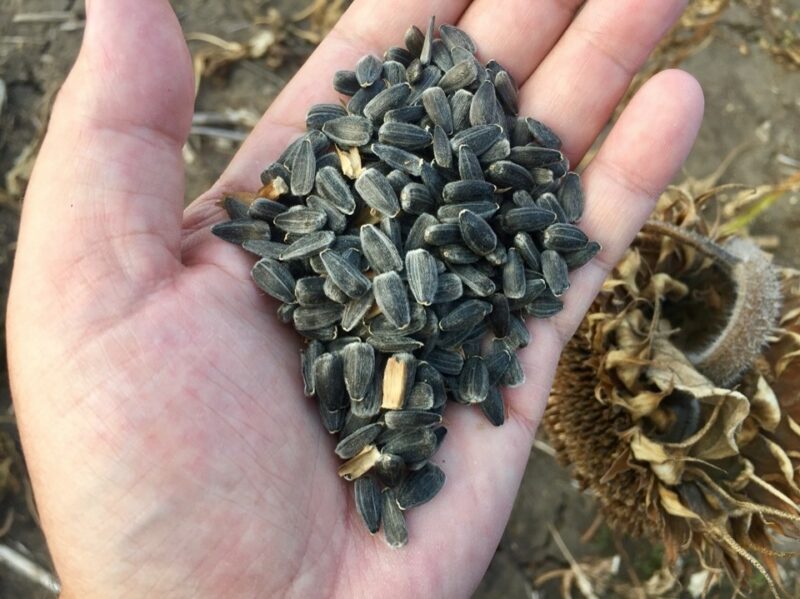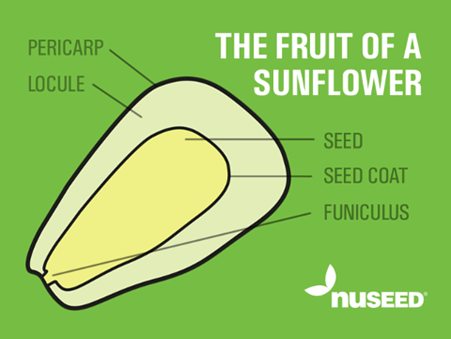We all know how sunflowers grow, but sometimes it’s helpful to look a little deeper into the biology to understand better the crop we grow, starting with the name.
Cultivated sunflower
The cultivated sunflower (Helianthus annuus) belongs to the plant family Asteraceae.
| · Sunflower | The name probably comes from the flower which resembles the sun. |
| · Helianthus annuus | Helianthus from Greek, Helios meaning sun, and anthos, meaning flower.
Annus from Latin meaning annual. |
| · Asteraceae | Commonly referred to as the aster, daisy, composite, or sunflower family.
Consists of over 32,000 species of flowering plants. The main common characteristic is hundreds of tiny individual florets contained in the flower head. |
Sunflower seed
Technically the sunflower ‘seed’ is a fruit containing a single seed.
| A fruit is a seed-bearing structure that is formed from the ovary after flowering.
“Fruit” also includes many other not commonly called “fruits”, such as nuts, bean pods, corn kernels, tomatoes, and wheat grains. |
Crack open a sunflower seed, and you’ll find two parts: the seed shell and the kernel. The seed shell is called the pericarp, and it helps protect the seed inside. The kernel contains the embryonic seed, which will develop into a new plant, and a food source to sustain it through emergence.


| The kernel is attached to the pericarp at its base by a stalk, called a funiculus, but is otherwise free from the inner wall of the pericarp. |
Germination
Once planted, the sunflower seed can start the process of germination, which involves four steps.
| 1. Water absorption
|
The first step in seed germination is for the dry seed to absorb water from the surrounding soil, known as imbibition.
Imbibition causes the seed to swell and rupture the seed coat, allowing the root to emerge. The newly emerged root is called the radicle. |
| 2. Respiration
|
Absorption of water causes metabolic activity in the seed to start up, including aerobic respiration.
Aerobic respiration is when the seed uses oxygen to turn fuel, such as starch, fats and sugars, into energy to produce the initial root and stem structures |
| 3. Mobilisation | As metabolic activity resumes, the cells of the embryo start to divide and expand.
They do this by using energy provided by aerobic respiration mobilised from starch, protein or fats found in the kernel. |
| 4. Development | After the energy has been made available, the cells of the embryo become metabolically very active.
The cells grow and begin dividing to develop the seedling. |
Emergence
Once germination begins, the primary root or radicle will emerge from the seed and grow downwards through the soil, anchoring the seedling.
Small root hairs will branch out from the primary root and explore the surrounding soil spaces looking for water and dissolved nutrients. Next, the plant stem or hypocotyl will emerge in a loop with both ends inside the seed coat.
As the hypocotyl elongates, it will either drag the seedling leaves or cotyledons from within the seed or carry the entire seed above the soil surface, where it will fall off as the cotyledons expand.
The hypocotyl emerges in a loop to help protect the growing point as it is pulled through the soil. Once the seedling leaves open, the growing point or plumule will be exposed, and the plant will emerge.
Roots
Sunflowers produce a single taproot that grows to around 1 metre deep but can exceed 1.5 metres, with smaller, secondary roots that branch off the main root.
The plant taproot will reach its maximum depth at flowering.
The secondary lateral roots populate the top 10 to 30 cm of the soil and can extend up to 1.5 metres outwards beyond the taproot.
Leaves

Leaves develop in pairs opposite each other, then later as singular alternate leaves up the stem until the final number of 20 to 40 leaves are reached.
The plant starts photosynthesis as soon as the first seed leaf unfolds and continues if green leaves are present.
The plant absorbs sunlight in its green chlorophyll, carbon dioxide through the leaves, and water through the roots to produce oxygen and sugars during photosynthesis.
The sugars are converted to carbohydrates and used for growth and development.
During vegetative growth, most products from photosynthesis are initially transported to the root system, then to the top of the plant once flower bud initiation starts.
Stem

The primary function of the stem is to support leaves, and transport water from the roots and products from photosynthesis to where they are needed.
Sunflower stems are rough and hairy and grow from 1 to 4.5 metres tall. They can have a diameter of up to 5 cm and can support flower heads over two kilograms.
Sunflowers are dicotyledons, and as such, the vascular bundles are arranged in a ring inside the stem.
The vascular bundle is a part of the transport system and contains the xylem, which transports water and dissolved minerals from the roots, and the phloem, which transport products from photosynthesis from the leaves.
If you break open the stem, you will also find a central core or pith, which is used to store food and water.
Flowers
Perhaps the most striking part of the sunflower plant is the flower, particularly when it’s in peak condition.
The flower is, in fact, two flowers, known as a compound head, with ray flowers and disc flowers.
The ray flowers are distributed around the head and have limited purpose beyond helping attract bees and other pollinating insects,
The disc flowers form the centre of the disc and, if pollinated, go on to produce seed. The disc flowers are arranged in concentric rings known as the Fibonacci Sequence.

| The Fibonacci Sequence is a series of numbers in which each number is the sum of the two preceding numbers (for example, 1, 1, 2, 3, 5, 8, etc.) and is found extensively throughout nature. |
During the flowering phase, the flowers progressively open from the outside of the disc towards the centre.
Each morning disc flowers open, and pollen is released, with most florets pollinated by wind or gravity.
If the floret is fertilised, then a seed will develop; if the floret is not fertilised, a hull may begin to form, but no kernel will develop, resulting in empty hulls at harvest.
Heliotropism
Heliotropism is the scientific term for a plant’s tendency to turn toward the sun.
| · Heliotropism | From the Greek, Helio meaning sun, and tropism meaning turning or movement of a living organism toward or away from an external stimulus, such as light, heat or gravity. |
Sunflowers are well-known for their heliotropism. Young sunflower plants track the sun from east to west during the day and then reorient themselves during the night to face east in anticipation of the sunrise.
Once flowering starts, they stop tracking the sun and remain facing eastwards, warming up more quickly in the morning, making them more attractive to pollinating insects.
The movement of the sunflowers is due to uneven growth; one side of the stem elongates during the day, the other during the night. This growth is driven by genes that respond to light and the plant circadian rhythm.

Seed set and grain filling
The factors that influence the number of grains and amount of grain fill are varied and complex, including genetic, physiological, agronomic, and environmental factors.
The number of grains is set early on, from the start of flower initiation to the first phase of seed fill, effectively from about 30 days before flowering to about 20 days after flowering.
Once flowering is finished, the plant will start to die back and ripen, ready for harvesting.
Overview
This was very much a brief overview of sunflower biology, which like all biology, is a complex subject. Still, we would recommend taking the time and effort to research the topic further.
The more we understand, the better informed our decision-making process will be.